Example: Creating a Custom Report
Below is an example of using the Report Wizard to create a custom administrator Actions report sorted by Site Name. The example assumes you have installed ARM with SQL Server Express and have performed administrator actions in EFT, such as creating users, stopping/starting sites, and so on.
-
In the administration interface, connect to EFT, click the Site on which you want to create the report, then do one of the following:
-
On the toolbar, click the click New Reports icon
 .
. -
On the main menu, click Reports >New Report.
-
Click the Reports tab, and then click the New Report icon
 on the bottom toolbar.
on the bottom toolbar.
The Create New Report dialog box appears.
-
-
Type a title for the new report, and then click Create. The Report Designer appears.
So far, all you have done is opened the VSReport Designer, which allows you to open the New Report Wizard, which we will do next. You will delete this "template" later.
-
Click File >New Report or click the New Report
 icon on the VSReport Designer toolbar. The New
Report Wizard appears.
icon on the VSReport Designer toolbar. The New
Report Wizard appears.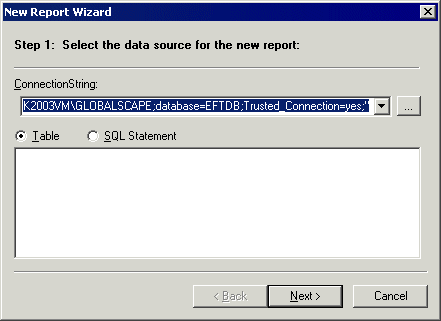
-
By default, the ConnectionString box displays information for the database that you specified when you installed the Auditing and Reporting module (for example, provider=SQLNCLI10;server=localhost\GLOBALSCAPE;database=EFTDB;Trusted_Connection=yes;). Click Next and go to step 5 or, if necessary, you can type a different string that is used to connect to the data source:
-
Click the ellipsis to define the connection string. The Data Link Properties dialog box appears.
-
On the Provider tab, click Microsoft OLE DB Provider for SQL Server as the provider to connect to the SQL Server database, and then click Next. The Connection tab appears.
-
In Select or enter a server name, click the arrow to select or type the name of EFT.
-
In Enter information to log on to EFT, click an authentication option to log on to EFT:
-
Use Windows NT Integrated security - Your computer automatically picks up the credentials from your computer and connects you to the database.
-
Use a specific user name and password - Specify the user name and the password to be used to log on to EFT. Select the Allow saving password check box to save the password in the connection string.
NOTE: Select the Blank password check box if EFT requires a blank password to log on the database server. Even if you do not type any password when you create a user account on a database server, you can select the Allow saving password check box. In this case, EFT takes a dummy password value and saves that value in the connection string. Selecting the Blank password check box disables the password field. -
-
Click one of the following:
-
Select the database on EFT, and then click a database in the list.
-
Attach a database file as a database name - Click the ellipsis icon
 to browse
for the SQL Server database file (*.mdf). The Select
SQL Server Database File dialog box appears. Select
a file, then click Open.
The path to the file appears in the Using
the filename box.
to browse
for the SQL Server database file (*.mdf). The Select
SQL Server Database File dialog box appears. Select
a file, then click Open.
The path to the file appears in the Using
the filename box.
-
-
Click OK in the Data Link Properties dialog box to return to the New Report Wizard.
-
-
Click Table, then click tbl_administratorActions.
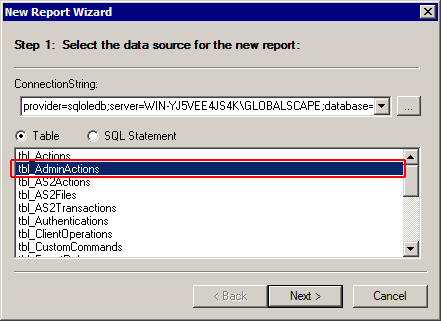
-
Click Next. The fields that appear in the Available list are from the table you selected in the previous step.
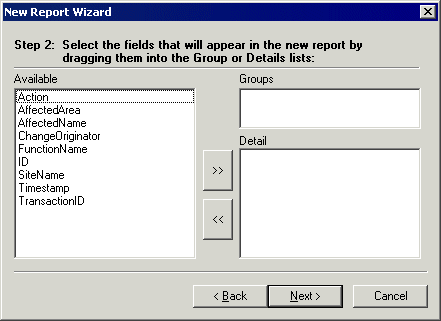
-
Click and drag SiteName to the Groups field, then click and drag each of the other fields, except ID and TransactionID, into the Detail box. (If you click the right-facing arrows, every field will move to the Detail area. Then you can individually move back the fields you do not want.)
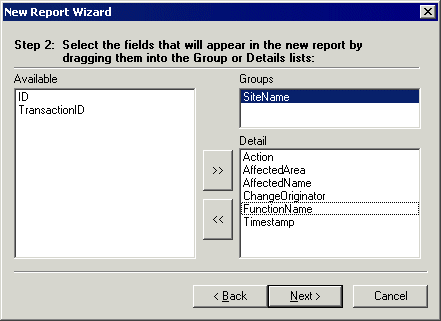
-
Click Next. The layout options appear.
-
Keep the default settings and click Next on each wizard page until you get to the last step. (For details of using the report wizard to define layout options, refer to Creating a Report with the Report Wizard. For this example, we used the default options.)
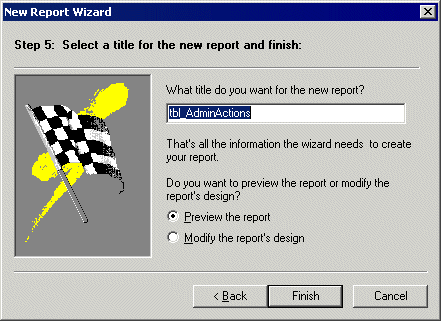
-
Type a title for the report, and then click Finish.
-
The left pane of the Report Designer displays the report's name (and the report template that was created in step 2).
-
The right pane displays a preview of the report.
-
The title bar displays the name of the report and an asterisk, indicating that you have not yet saved the report.
-
-
Let's get rid of that "new" template that was created when you opened the VSReport Designer. In the left pane, click the name of the template you want to remove, and then click the delete icon
 on the toolbar. Click OK to dismiss the warning message.
on the toolbar. Click OK to dismiss the warning message. -
Click File > Save or click the Save icon on the toolbar.
-
Click File > Exit to close VSReport Designer.
-
On the Reports tab, expand the Custom Reports node. The new report appears in the tree.
-
In the Custom Reports node, click to select the new report.
-
In the right pane, click Show Report. The report appears in the preview pane.

You can filter the results, such as show results only for certain Sites, a specific administrator account, or a certain date.
-
Click Save As to save the report. The report displays EFT administrator actions sorted by Site Name and Server.